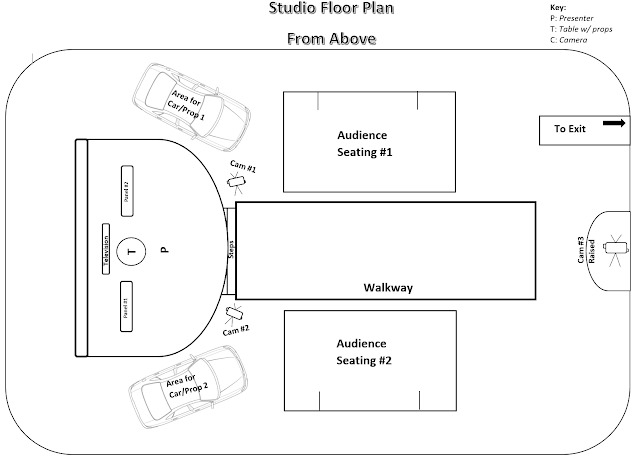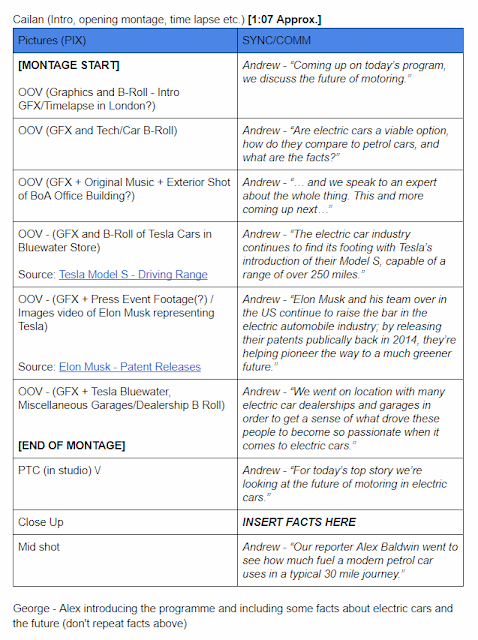TV News Unit | Lecture - Writing & Storytelling For News
One must also understand the medium, in Television the script must never do in words what the picture is doing in images. Radio for example must sufficiently convey the 5 W's (Who, What, Where, When, Why?)
What sort of story do we want to tell? Do we want to invoke an emotion, fear, empathy, sympathy etc. Would we rather tell the information of an event as plain and simple as they possibly could be? These are all choices we must consciously make as film-makers.
CONTENT
STRUCTURE
PURPOSE
Count the words in each sentence, if the average amount of words is more than 16 they're too long. What we are trying to do is tell a story, paint an imaginary image and bring someone back to the events that took place.
Clarity and precision is key, if the cost of something is high, say it's high. Not considerable or significant. Filter your scripts for tired word pairs, phrases etc that just don't need to be there.
Never use a metaphor whose literal meaning you don't actually understand. E.g. if an election is in the offing, why not simply say "soon".
Your listeners only have a single chance to hear what you're saying so write, re-write and re-write again. Each time simplifying the language in which you are expressing yourself. Is it worth getting someone who doesn't know your story to watch it before handing it in, simply to catch out various potential points of confusion for the audience.
Alliteration - e.g. the Players taking Polo to the Park.
Avoid Repetition - say things once, tease out thoughts and set them up - AVOID saying what the person in interview is about to say!
Wordplay - e.g. It's a new Dawn for Jennifer - the comedy partnership spanning thirty years is finally over...
Rule of Three - One or two is too few, use a minimum of 3 examples for anything in order to provide a decent sample.
Similes and Metaphors - useful to add comparisons and context - RELATABLE e.g. He ran like the wind!
Personification - use with caution to avoid cliches!
Exaggeration - Giving emphasis can help e.g. MASSIVE rats in London.
The 'Page F Test'
Precision
- Use language correctly! SPAG
- Spelling and Grammar
- As Tom Stoppard said: "I don't think writers are sacred, but words are. they deserve respect"
Accuracy
- This goes hand in hand with trust - ensuring that you present the FACTS accurately is a given in any form of journalism. Check your FACTS with RELIABLE sources.
- Nothing is as insulting as a report in which names or titles are inaccurately represented - again make sure you CHECK you FACTS.
- In an age where news travels digitally, mistakes can be made easily.
In 2013, Sally Bercow was ordered to pay £15,000 damages plus six figure legal costs due to the uncovering of material via social media.
Germane
- I.e. Relevant - Are all the facts necessary? Test them for relevance to ensure your story is TIGHT and does not waste time on unnecessary elements.
- In order to do this you need to KNOW YOUR STORY.
Equitable
- Ensuring BALANCE is a key task in journalism. Making sure you view your story OBJECTIVELY and give equal priority to all central parties.
Flow
- LOGIC - the 'natural order' of the story elements, structure carefully and walk the viewer through the story.
- TIE-WRITING - using scripting to naturally link or corner turn from one point to the next.
Write It In The Correct Order
- Write the LEAD IN first (the intro to the story read by the news anchor), then the PACKAGE and then your TAG (optional - additional information/facts read by presenter before the report after the 'lead'). Beware:
- DON'T REPEAT THE LEAD IN WITHIN YOUR PACKAGE
- BEWARE WORDY WRITING.
How to Write a Good Lead
- Attention Grabbing
- Conccise and not overloaded with facts
- Should sound fresh/"new"
- Be written in an 'active voice'
- Be Creative
- Conversational in tone
- Use the narrative within the story.
Attention Grabbing
Distilling your idea into a clear TOP LINE is a great war of both clarifying your purpose and in turn communicating that to the viewer.
They can therefore decide whether it's RELEVANT to them and therefore whether they wish to watch the item! Avoid a "SO WHAT?" response!
Think of it like your LOGLINE that you would use in a pitch.
Concise and Fact-Light!
Don't weigh down your leads with facts - remember to keep them to the salient points in terms of their IMPACT - this might include one headline if it is very relevant and 'shocking/impactful'.
e.g. Figures announced today revealed a record rise in unemployment with an increase of 500,000 signing on since this time last year.
The facts belong in the MAIN BODY of your piece, an important tip is always to keep each sentence based around a single thought.
E.g. It was supposed to be the race of their dreams, but it's become a nightmare as four Britons go missing, feared dead on Round the World Yacht Race...
Rather than...
"Four men went missing at 18:00 hours GMT yesterday approximately 50 miles off the coast of Dover.".
Finding an 'active voice'
An active voice will enhance and rive your narrative. Subject, Verb, Object.
E,g, ENGLAND BEATS ARGENTINA! CELEBRATIONS ON THE PITCH AS THEY TAKE A STEP CLOSE TO WORLD CUP VICTORY.
Conversational Tone
Write as if you are importing some important news to a friend - almost a 'gossip' voice - write as you speak...
Things to Avoid...
'Journalese' - artificially exaggerated or embellished writing - those well work phrases which are so familiar they feel like a parody.
__________________________________
Don't Forget Your Viewer
Use words such as 'You' to connect with those watching and again answer the 'Why should I care?' question.
Headlines and Coming-Ups
The other important tool in writing for news is creating your HEADLINES - these are the initial brief SELLING TOOL for your stories.
It is a menu of the main stories and delivers them in an order which usually reflects the level of newsworthiness of each story.
Scripting OOV/SOT
Scripting this sort of story requires the ability to discern good sound bites from interviews and script in and out of them.
The studio script must indicate when and where the video is supposed to start and its duration so that the director is forewarned.
Additionally, you need to ensure that the presenter is aware of when to stop reading the VO and allow the SOT to take over.
Scripting A News Package
If possible work out key elements of your film on paper before filming.
Work out your shot list and scripted elements such as the PTC.
Scripting will allow you to be sure you know WHAT you need to shoot.
Ensure you give your reporter a PURPOSE - make them ACTIVE in your film.
Narrative Development
Driving the narrative of your story lead ins is a great way to keep it NEW even if it had already happened.
Prepare for the Edit!
Prior to editing you will need to view, log and transcribe your interviews - you can note them rather than transcribe word-for-word.


Comments
Post a Comment